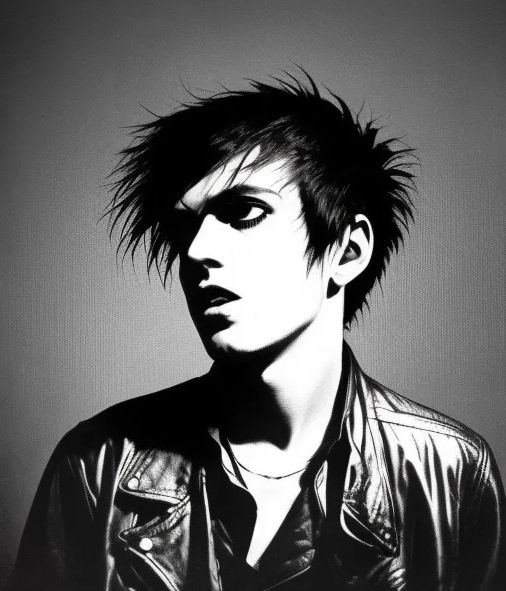Around The Pit: What Is Post-Punk
In this article, we're gonna dish out all the juicy deets about Post-Punk - where it came from, what makes it tick, and how it shaped the crazy-cool music scene we have today.

Picture this, you're at a show with your buddy, and they start gushing about this awesome new band they're into, claiming they're a Post-Punk band. Now, you're familiar with punk - the mohawks, combat boots, and rebellious anthems - but what's the deal with this "post" punk thing? Are they just punks with a hangover from their anti-capitalist serenades? Well, fear not, my curious friend! In this article, we're gonna dish out all the juicy deets about Post-Punk - where it came from, what makes it tick, and how it shaped the crazy-cool music scene we have today.
Origin Of The Genre
Post-Punk emerged as a direct response to the punk rock movement of the mid-1970s. Punk, characterized by its raw, energetic, and rebellious nature, shook the music world with its anti-establishment ethos. However, as the initial punk fervor waned, some musicians sought to transcend its limitations and expand its sonic boundaries.
The term "Post-Punk" was coined retrospectively to describe the music that followed the first wave of punk. It was initially used to classify bands such as Siouxsie and the Banshees, Joy Division, and Gang of Four. These artists, along with many others, delved into a more introspective and experimental realm, blending punk's aggression with art rock, new wave, and other avant-garde influences.
So lets put it this way, punk rock is out there, setting the music world ablaze with its fire, but then comes Post-Punk, all like, "Hold my guitar!" It popped up in the late 70s and early 80s as a way for musicians to go wild with creativity. They took punk's raw energy, added some artsy vibes, and voila - a brand-new genre that flipped the music scene upside down. So in essence, you could say it's like punk rock's rebellious cousin who's into art, introspection, and causing a musical ruckus.
So what are the musical characteristics of Post-Punk?
- Sonic sounds - Post-Punk artists were not content to stick to traditional rock structures. They experimented with dissonant guitars, unconventional song arrangements, and atmospheric soundscapes.. you know, funky sounds, weird guitar stuff, and trippy arrangements that left everyone scratching their heads and grooving to the beat. This approach opened up new possibilities for musical expression. Post-Punk artists wanted to color outside of the musical box and this was it.
- Deep thoughts and emo feels when it comes to lyrics - Post-Punk lyrics often explored darker and more profound themes, touching on existentialism, alienation, political unrest, and societal critique. Emotionally charged vocals became a hallmark of the genre. If punk was the crazy kid at the party, Post-Punk was the one chilling in the corner, pondering the mysteries of the universe, the meaning of life, feeling like an outsider, and all those things that make you go "whoa."
- Danceable Rhythms - Contrary to its moody and introspective themes, Post-Punk often boasted danceable rhythms. Basslines became a driving force, complemented by intricate drum patterns, inviting listeners to dance despite the genre's brooding undertones. They have this magnetic rhythm that makes you wanna dance like nobody's watching. Trust me, you'd forget all your problems while shaking it to those basslines!
- DIY Ethos - Post-Punk musicians maintained the punk spirit of independence and authenticity. These musicians had a punk spirit alright - they DIY-ed their way into the music world, recording their music on low budgets and forming their record labels. No big fancy studios for them.
Legacy Of The Genre
Post-Punk didn't just hit the music scene and fade away like a one-hit wonder. Oh no, it was the wild seed that sprouted a whole forest of musical genres. Post-Punk's influence has been vast, reaching far beyond its initial emergence. Its impact can be seen in various sub-genres and movements that followed, including new wave, gothic rock, indie rock, alternative rock, and more.
- New Wave - Post-Punk's coolness rubbed off on new wave bands, and they started twiddling with synthesizers and creating dance-pop magic. Suddenly, bands like Depeche Mode, New Order, and The Cure were born, making the world groove even harder.
- Gothic Rock - Post-Punk laid the groundwork for the emergence of gothic rock. Remember those brooding lyrics and haunting soundscapes? Well, they inspired the gothic rock movement. Artists like Bauhaus and The Sisters of Mercy embraced the darkness and turned it into art. They built upon these elements to create a darker and more theatrical aesthetic.
- Alternative and Indie Rock - Many bands in the 1980s and 1990s drew inspiration from Post-Punk's embrace of individuality and experimentation. These bands helped shape the alternative and indie rock scenes, becoming influential figures in their own right.
Post-Punk was the genre that shook things up, took risks, and made people think and dance at the same time. It's like the rebellious, artistic sibling we all wish we had. Post-Punk stands as a pivotal moment in music history, showcasing the transformative power of artistic evolution. From its unconventional sound to its emotionally charged lyrics, Post-Punk challenged the status quo and pushed the boundaries of what music could be. Its legacy can be felt in the diverse array of musical genres that followed, solidifying its place as a genre that forever changed the musical landscape. Whether you're a seasoned music enthusiast or a newcomer, exploring the world of Post-Punk will undoubtedly enrich your appreciation for the evolution of sound and expression.
Cross Over Genres:
New Wave, Dream Pop, Goth Rock, Death Rock, No Wave, Dark Wave

